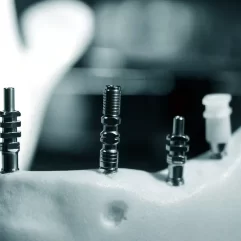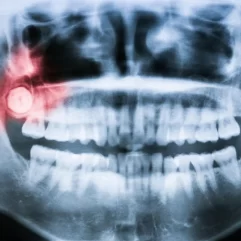Understanding Dental Crowns: Types, Materials, and Costs
Cost-Effective Solutions for Dental Crowns in Mexico
What is a Dental Crown?
A dental crown is a fitted cap that covers a tooth that has suffered damage from decay or trauma. It can restore its size, shape, and appearance. Crowns can be made from different materials, such as ceramic (porcelain), metal, or a combination.
For a crown to be fitted, your tooth will be shaped for the crown, an impression will be taken to make the crown, and then the crown will be permanently cemented onto the tooth.
What is the Difference Between a Crown and a Cap?
Dental crowns and “caps” are often used interchangeably for the same dental procedure. Both involve a tooth-shaped cover placed over a tooth to restore its shape, size, strength, and appearance. Here’s a more detailed look at each.
Dental Crowns:
- A dental crown is a tooth-shaped cover that completely encases the tooth’s visible part. It is commonly used to treat a cracked or damaged tooth, severe tooth decay, or to cover up dental implants.
- The primary difference is the amount of tooth structure they cover. A tooth cap covers the biting surface and only one or two sides, while a crown completely encases the tooth. Tooth caps are less invasive and usually less expensive than dental crowns.
- Lastly, crowns can be made from various materials, including gold, silver, porcelain, porcelain-fused-to-metal (PFM), and ceramic.
Dental Caps:
- A tooth cap, also known as an onlay or inlay, covers only a portion of the tooth surface instead of the entire structure.
- It treats tooth decay, fractures or cracks in molars and premolars, tooth trauma, or tooth sensitivity.
- Like crowns, caps are typically made of porcelain and can be custom-made to match your tooth’s color.
Why Are Dental Crowns Necessary?
There can be many reasons a dental crown is necessary:
- The tooth is weakened, broken, or worn and must be restored.
- A dental crown may be required to cover and protect a tooth with fillings, leaving little of the remaining tooth.
- To conceal discolored or otherwise damaged teeth for cosmetic reasons.
- To hold a dental bridge in place or to cap a dental implant.
- To conceal misshapen or discolored teeth.
- Teeth that have had root canal treatments.
The Process of Getting a Dental Crown
Depending on the dental clinic location, the dental crown procedure usually requires one or two visits. This usually involves some tooth filing to ensure the dental crown can fit over the remaining tooth structure. In cases of extreme damage to the original tooth, or if the roots are damaged to the point that they can’t support the dental crown, a root canal may be performed first.
Then, the dentist will take either a physical impression or a digital image to determine who will fabricate the replacement dental crown to fit correctly in the space and accommodate your bite. If the impression has to be sent to an off-sight lab, a temporary dental crown covers the prepared tooth until the permanent crown is placed.
You may also hear the terms “on-lays” or “3/4 crowns”. These variations from traditional dental crowns involve covering less of the natural tooth. As expected, these variations cover less of the underlying tooth and are used only in exceptional circumstances.
If you’re fitted with a temporary crown, there are some precautions we recommend:
- Avoid sticky or gummy foods such as gum or caramel candy on the side where the temporary is placed.
- When you can chew more frequently on the other side of your mouth
- Alter your flossing techniques. Slide floss through and out the side, rather than lifting the floss between the teeth, which can dislodge the temporary dental crown
What Materials Are Dental Crowns Made From?
If your dentist uses a conventional dental laboratory to make your crown, they’ll fit your tooth with a temporary crown while the final one is being made.
Temporary crowns:
Temporary crowns are often made from composite resin, acrylic, or another plastic material. They may also be made from aluminum. These less durable materials are used because temporary crowns are generally meant to last only a few days or weeks.
Permanent Crowns:
- Permanent crowns are typically made of:
- Ceramic or porcelain, such as zirconia or lithium disilicate
- Metals, such as gold- or silver-based alloys, titanium, or stainless steel
- Metal-ceramic or PFM (porcelain fused to a metal framework)
- Composite resin, similar to that used in dental fillings
Which material your dentist uses will depend on your needs and preferences, as well as the availability of the material. Your dentist may also have a preference for specific materials.
Over time, most dentists have preferred ceramic and zirconia materials over metal, especially for front teeth. This is because:
- Ceramics mimic the natural tooth color
- Newer, more durable ceramics continue to be developed
- Ceramics can be low-cost compared to certain metals
Of the different kinds of ceramic, zirconia is the strongest and is becoming more popular for back teeth, especially in people who grind their teeth.
High-performance plastics such as PEEK and PEKK have also recently been introduced in dentistry and may be a promising alternative to zirconia.
You and your dentist must weigh the pros and cons of these different materials. After evaluating your situation, your dentist can recommend a specific material.
When is a Dental Crown Necessary?
There are various reasons for someone to have a crown placed. For example, your dentist may recommend a crown to:
- Restore a broken or otherwise damaged tooth
- Cover a tooth with a large filling
- Protect a tooth after root canal therapy
- Cover the abutment of a dental implant
- Generally, a crown is necessary when the tooth in question would otherwise:
- Be vulnerable to further damage or infection
- Cause pain during normal daily activities
- Not be able to function like a tooth normally would
- Affect your bite
- Detract from your smile
Benefits and Risks of Dental Crowns:
Crowns are indicated (recommended) for multiple situations. However, they aren’t entirely without risks, especially if they don’t fit well or your oral health is poor.
Benefits:
- Dental crowns provide several benefits, including:
- Restoring normal tooth shape and function
- Improved aesthetics (a better-looking smile)
- Protecting the underlying tooth from infection or further damage
- Allowing for natural underlying tooth structure to be kept (as opposed to extracting natural teeth and placing implants)
Risks:
- Crowns also have potential complications, especially if they don’t fit properly. These may include:
- Heightened sensitivity
- Wear or damage to the opposing teeth over time
- Chipping or breaking
- Loosening or falling out
- Allergic reactions (to the nickel in metal crowns, for example)
- Tooth decay or gum disease surrounding the crown
If you are concerned about the risks, talk to your dentist. They can determine if a crown is right for you.
What is the Cost of Crowns in Mexico?

Calculating Savings: Affordable Options for Dental Crowns in Mexico.
The cost of a dental crown can vary widely by factors such as local competition in your city or even where you live in the US. Prices for a crown also vary depending on the material and your insurance. The total cost of a crown may be anywhere from $500.00 to over $2,500.00.
Here are the average costs of crowns in the US with insurance:
- Ceramic or porcelain: $800.00 – $3,000.00 *per tooth
- Metals: $600.00 – $2,500.00 *per tooth
- Metal-ceramic or PFM: $500.00 – $1,500.00 *per tooth
- Composite resin: $400.00 – $600.00 *per tooth
- Certain types of all-ceramic crowns, such as CEREC crowns, are typically more expensive
Insurance may cover as much as half the cost of dental crowns. However, if your crown is considered cosmetic, the insurance may cover very little or none of the procedure.
How Much Can I Save on Crowns in Mexico?
Prices for crowns in Mexico start at $490.00, a savings of over $1,000.00 per crown in some cases. Our approved dental clinics use the same materials as those in the US. Check out our How Much Can I Save page for a more detailed breakdown of cost savings.
One way to get quality, affordable dental crowns in Mexico is to consider following in the footsteps of thousands of other Americans and Canadians — traveling across the border to Dental Clinics in Mexico. Dentists in Mexico offer high-quality crowns, usually zirconia crowns, at much lower prices than dentists in the US. In 2024, the average cost for a zirconia crown in Mexico is between $475.00 to $490.00. That’s a significant saving.
You may also have questions about the quality of crowns in Mexico due to the price disparity; be sure to visit our What About the Quality? Page.
Dental Crown Procedure: What to Expect
The process may require more than one visit. Your tooth must be prepared (cleaned and shaped) for your crown to be placed. Then, the dentist will make an impression so that a dental laboratory can create your crown.
In most cases, unless a patient has an active infection, it takes, on average, two or three days for our patients to get a crown, whereas in the US, it can take several days or weeks for your new crown to come back from the lab. In some cases, they place a temporary crown. When the permanent crown is ready to be placed, our doctors will remove the temporary crown and cement the permanent crown in place.
You can expect your crown procedure to look something like the following:
Initial Exam:
First, your dentist will take X-rays and examine your mouth to determine if your teeth need crowns.
Your dentist will ensure the ceramic shade matches your surrounding teeth, especially for a front tooth. They may be able to show you samples of the final result. You may even be able to get custom shading done to provide a better match.
Preparing the Tooth:
Your dentist will need to prepare your tooth to receive the crown. Some teeth may have to be filed away to ensure a good fit.
Before preparing the tooth, your dentist will inject local anesthesia. They’ll begin work once the tooth is thoroughly numb. Your dentist may place a build-up or perform a root canal if there is tooth decay or an injury to the tooth’s pulp.
Regardless of the type of work, the dentist will try to preserve as much of the tooth as possible. At the same time, some viable tooth structures may have to be filed down. Otherwise, a weak crown could contribute to a more significant loss of healthy tissue in the long run.
Impressions and Crown Fabrication:
Once your tooth has been prepared, the doctor will make an impression of your tooth. Some clinics use a special silicone-based putty, but most of our clinics take impressions digitally with an Itero Element Intraoral 3D scanner.
Temporary Crown:
While waiting for your permanent crown to return from the lab, your dentist will make a temporary crown. This will protect your tooth and prevent any tooth shifting that might make it challenging to fit the permanent crown. When the temporary crown is ready, they’ll securely attach a temporary dental cement to your tooth.
Permanent Crown:
At your next appointment, your dentist will remove your temporary crown and replace it with your new permanent one. The permanent one may still need some slight adjustments. It must be shaped perfectly to adhere to your tooth and provide a perfect seal.
Once your dentist is sure your new crown has a proper fit, they’ll attach it to your tooth. They’ll use a solid dental cement meant to last for years.
After securely placing your permanent crown, your dentist will check to ensure your bite remains even. Sometimes, they may slightly file down the opposing tooth that makes contact with the crowned one.
Aftercare:
After the procedure, your dentist provides instructions on how to care for your crown. Some aftercare instructions include:
- Avoid using too much pressure when brushing
- Floss regularly, but make sure to do it gently
- Don’t eat hard and sticky foods like nuts or popcorn
- Chew on the other side of the mouth
- Use an over-the-counter topical gel or a pain reliever if needed
- Visit your dentist every six months for routine cleanings and checkups
How Long Do Crowns Last?
Most crowns can last for fifteen years or more. Some may not last more than a few years, however. The material, your diet, your oral health, and the location of the crown are all factors in how long it will last. Metal-ceramic (PFM) crowns may outperform all-ceramic crowns over the long term (8 years or more), and zirconia crowns may last longer than other kinds of ceramic. Composite resin crowns tend not to last as long as other crowns. This is why dentists use composite resin more often for temporary crowns than permanent ones.
Problems that Can Arise with Dental Crowns:
In most cases, dental crowns are well-accepted by the body and cause few problems. While there may be sensitivity in the beginning, this usually resolves quickly. If you have a continuing sensitivity issue, you could consider one of many unique kinds of toothpaste developed for tooth sensitivity. If your bite does not feel right, the height of the crown may need to be adjusted. This is easily adjusted and not uncommon.
A dental crown may become loose or even fall off in some cases. Many things can cause this, including a lack of adequate cement at the time of permanent placement or, in some cases, an improper fit.
Dental crown materials or cement can cause an allergic reaction in sporadic cases. However, extensive research has been used to develop biocompatible materials, and it is improbable that you will have such a reaction.
In Conclusion
Dental crowns are a kind of dental restoration. They cover an existing tooth to protect and restore its original shape.
Crowns can be made from different materials depending on your specific situation. The process of preparing your tooth and making the crown can be complex.
Dental tourism in Mexico is very safe, and you can save a lot of money on dental crows if you know where to go and which dental clinics to use. Researching dentists, reading patient reviews, and ensuring you’re traveling to a city that caters to dental tourists is essential. The best way to ensure you work with a reputable dentist in a safe city is to work with a dental tourism agency.
If you have questions or need additional information, please Contact Us or Request a Quote to send us your dental inquiry, and we’ll get back to you.












